
Top Tips for Choosing the Right Material for Your Deck
When it comes to enhancing your outdoor space, selecting the right decking material is crucial for both aesthetics and durability. With so many options available—from the timeless appeal of wood to the modern innovations of PVC, composite, concrete, and vinyl—making an informed choice can be overwhelming. Each material has its own set of benefits and drawbacks, tailored to different needs and preferences.
PATIOS & DECKS
12/25/20239 min read
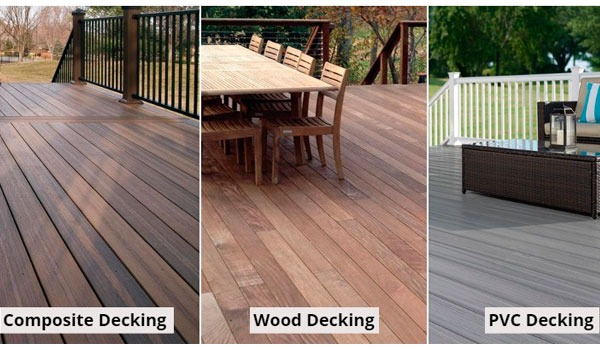

Understanding Your Decking Material Options
When embarking on a patio or deck project, the first crucial decision you'll need to make is selecting the right material. This choice can significantly impact not only the aesthetic appeal of your deck but also its longevity and maintenance requirements. The common materials include composite, vinyl, wood, PVC, and concrete. Each has its own set of benefits and drawbacks that must be considered to make an informed decision.
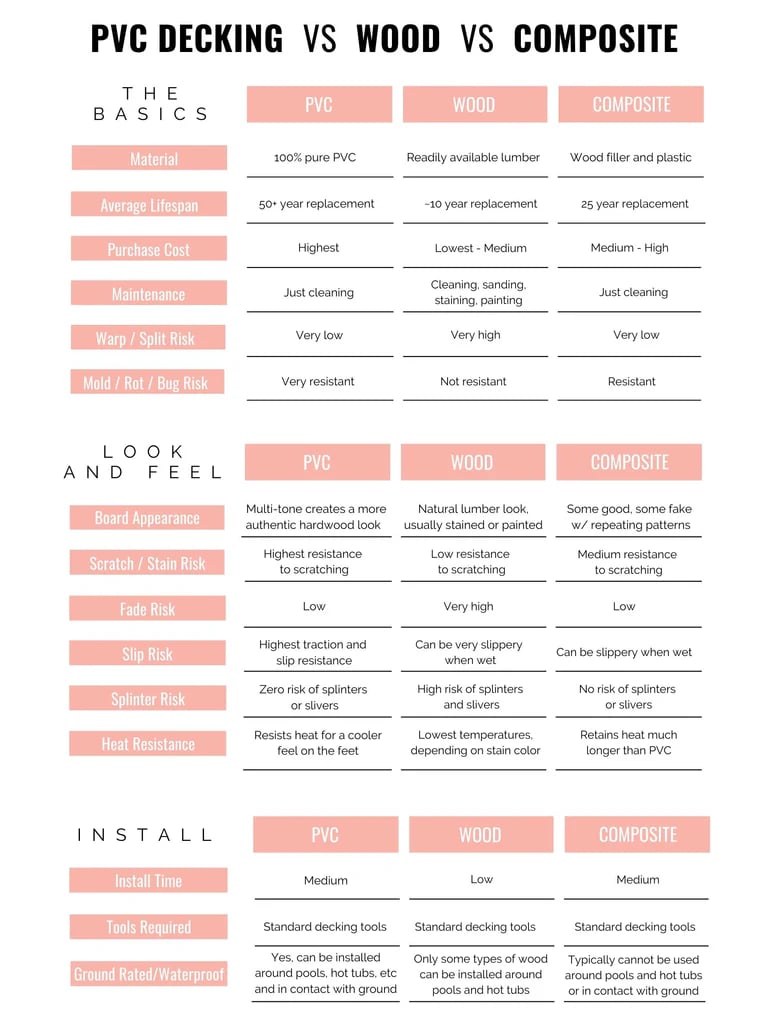

Modern Decking: PVC vs. Composite - Choosing the Perfect Material for Your Deck
In the realm of outdoor living spaces, modern decking materials have revolutionized the way we think about durability, aesthetics, and maintenance. Gone are the days of traditional wood decks that require annual upkeep and are susceptible to weathering. Today, PVC and composite decking offer compelling alternatives that blend the beauty of natural wood with unmatched longevity and ease of maintenance.
Understanding PVC Decking
Polyvinyl chloride, or PVC, decking is a synthetic option that eschews organic materials in favor of durable polymers. This makes PVC exceptionally resistant to water, mold, and mildew, perfect for humid climates or areas near water sources. The absence of wood pulp ensures that PVC boards won't warp, crack, or splinter, maintaining a pristine appearance over decades.
In recent years, advancements in PVC technology have addressed previous concerns about heat retention and artificial appearance. High-quality options and advanced PVC decking now boast hype realistic wood textures and a spectrum of colors, offering versatility and aesthetic appeal without the drawbacks of traditional wood.
Pros of PVC Decking:
Low Maintenance: Requires no annual sealing or staining.
Durability: Resistant to rot, insects, and moisture damage.
Longevity: Lifespan of 50+ years, outlasting both wood and composite alternatives.
Safety: Slip-resistant and ideal for poolside or wet area installations.
Aesthetics: Varied grain patterns and colors available to suit any design preference.
Cons of PVC Decking:
Upfront Cost: Initial investment can be higher compared to wood or basic composite options.
Quality Variation: Lower-quality PVC may exhibit heat retention or artificial appearance issues.
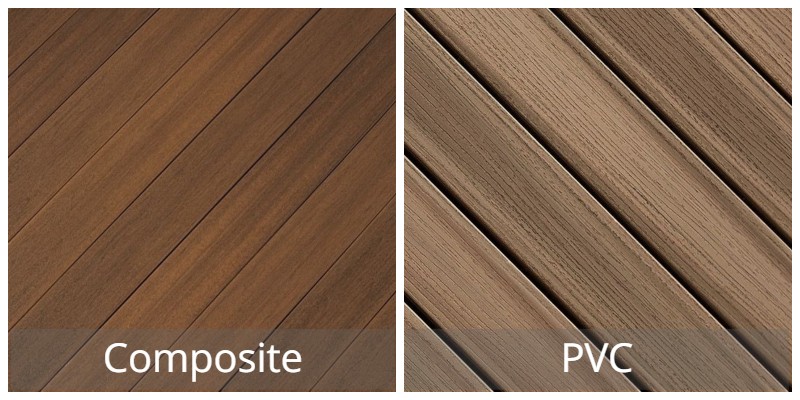

Exploring Composite Decking
Composite decking blends organic wood fibers with synthetic polymers, striking a balance between natural aesthetics and enhanced durability. This material offers excellent resistance to moisture, fading, and stains, thanks to advanced polymer capping on three or four sides of the boards. This protective layer ensures that the core remains intact and free from moisture damage, extending the lifespan of the deck significantly.
Composite decking exemplifies this blend of performance and style, providing homeowners with a wide array of colors and textures that mimic the look of real wood without the maintenance hassles. While slightly less durable than PVC, composite decking still outlasts traditional wood by a significant margin and offers considerable cost savings over its lifespan.
Pros of Composite Decking:
Natural Appearance: Mimics the look of wood without the upkeep.
Durable: Resists fading, staining, and mold, extending deck life to 25-30+ years.
Affordability: Generally more budget-friendly than PVC, with lower upfront costs.
Environmental Impact: Often made from recycled materials, promoting sustainability.
Cons of Composite Decking:
Installation Complexity: Some types require specific substructures due to flexibility.
Uncapped Varieties: Prone to moisture damage if not properly protected.
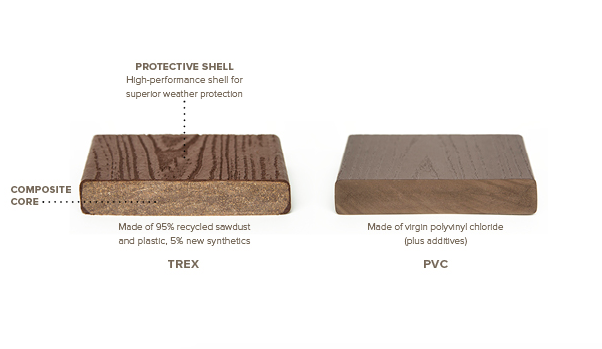

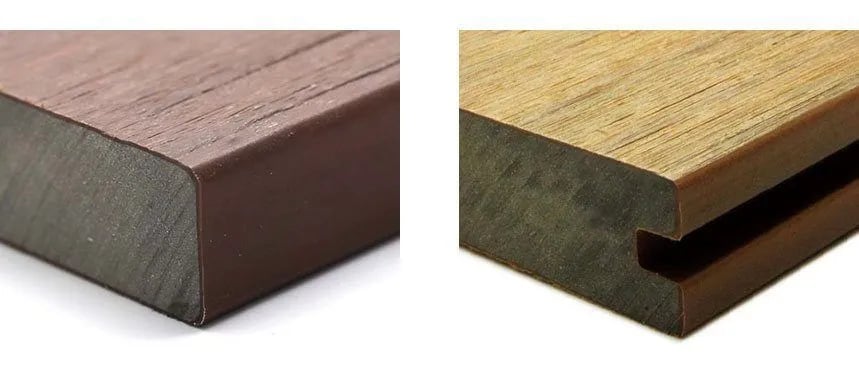

Capped Manufactured Decking: Enhancing Performance
For those seeking the ultimate in durability and longevity, capped manufactured decking combines the best attributes of both PVC and composite materials. Featuring a polymer cap on all sides of the board, this type of decking offers unparalleled protection against moisture, mold, and fading. It's an ideal choice for homeowners looking to minimize maintenance while maximizing their outdoor enjoyment.
Choosing Between PVC and Composite Decking
The decision between PVC and composite decking hinges on several factors, each crucial to achieving the perfect outdoor space tailored to your needs:
Longevity: Opt for PVC if you prioritize maximum lifespan and minimal maintenance.
Water Resistance: PVC is superior in wet environments or near pools due to its non-porous nature.
Budget Considerations: Composite decking offers initial savings without sacrificing durability or aesthetics.
Ease of Installation: PVC's lightweight properties make it easier to handle during installation, suitable for DIY projects.
Wood Decks: Pros, Cons, and How They Compare to Composite and PVC
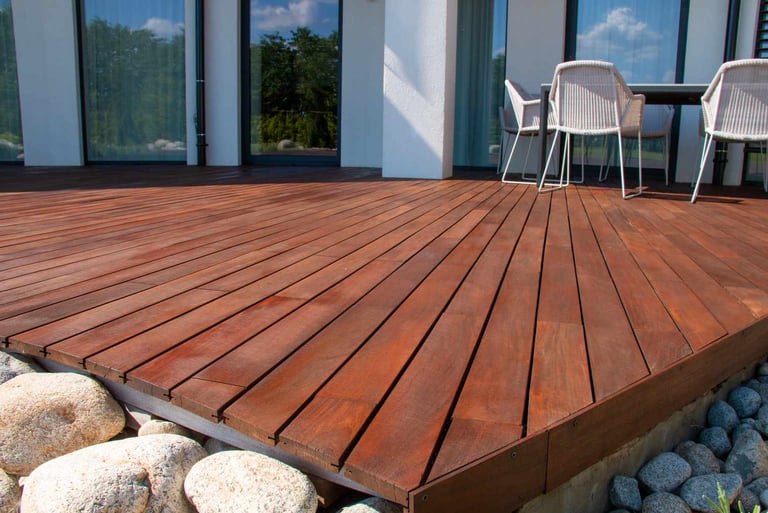

Wood decks have long been a staple of outdoor living spaces, celebrated for their natural beauty and classic appeal. However, as decking technology has evolved, alternatives like composite and PVC materials have emerged, offering unique advantages and challenges. Here’s a closer look at the pros and cons of wood decks, along with a comparative analysis of their costs versus composite and PVC options.
Pros of Wood Decks
Natural Beauty: Wood decks provide an unmatched, natural aesthetic that many homeowners find irresistible. The grain patterns and rich hues of wood create a warm, inviting atmosphere that synthetic materials often struggle to replicate.
Cost-Effective: Wood decking, particularly pressure-treated lumber, is generally less expensive upfront compared to composite and PVC options. This makes it an attractive choice for budget-conscious projects.
Ease of Installation: Wood is relatively straightforward to work with, making it easier for DIY enthusiasts to tackle. Standard tools and techniques are sufficient for most wood deck installations.
Customizability: Wood decks can be easily stained or painted to achieve a desired look. This flexibility allows homeowners to update the deck’s appearance as tastes or trends change.
Sustainability: When sourced from responsibly managed forests, wood is a renewable resource and can be a more environmentally friendly option compared to synthetic alternatives.
Cons of Wood Decks
Maintenance: Wood decks require significant upkeep to maintain their appearance and longevity. Regular sanding, sealing, and staining are necessary to protect against moisture, UV rays, and general wear and tear.
Durability Issues: Wood is susceptible to rotting, warping, and splintering, especially if not properly maintained. Termites and other pests can also pose a threat to wooden decks.
Shorter Lifespan: Compared to composite and PVC, wood decks typically have a shorter lifespan. Traditional wood decks last around 10-15 years, depending on maintenance and exposure.
Weather Sensitivity: Wood can expand and contract with temperature fluctuations and humidity changes, leading to potential warping or cracking.
Exploring Vinyl Decks and Patios: A Durable Alternative for Outdoor Spaces
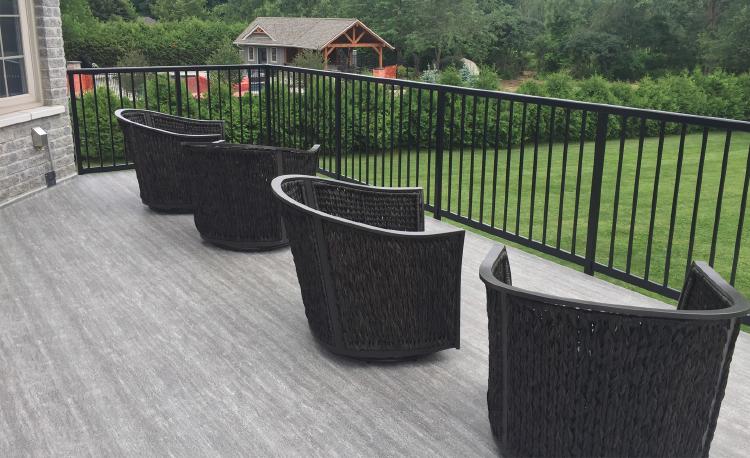

Vinyl decking and patio materials offer a modern solution for homeowners seeking durability, low maintenance, and a versatile aesthetic for their outdoor spaces. Here's a brief overview of what vinyl has to offer and why it might be the right choice for your next project.
What is Vinyl Decking?
Vinyl decking is made from polyvinyl chloride (PVC), a type of plastic that provides a resilient surface for outdoor use. Unlike traditional wood or composite options, vinyl is entirely synthetic, which translates into a host of benefits including superior resistance to moisture, stains, and fading.
Benefits of Vinyl Decking:
Low Maintenance: Vinyl decking requires minimal upkeep. It doesn't need to be sealed or stained, and it's easy to clean with just soap and water. This makes it a convenient option for busy homeowners.
Durability: Vinyl is highly resistant to environmental elements such as rain, snow, and UV rays. It won’t warp, crack, or splinter like wood, and it's less prone to mold and mildew growth compared to some other materials.
Variety of Styles: Modern vinyl decking comes in a range of colors and textures, including options that mimic the look of natural wood. This allows you to achieve a stylish appearance without compromising on durability.
Weather Resistance: With its excellent moisture resistance, vinyl is ideal for areas prone to high humidity or heavy rainfall. It’s also well-suited for poolside installations due to its slip-resistant properties.
Drawbacks of Vinyl Decking:
Initial Cost: Vinyl decking can be more expensive than traditional wood, though its durability often justifies the higher upfront investment.
Heat Retention: Some vinyl decks can become quite hot under direct sunlight, which may be uncomfortable to walk on during peak summer months.
Concrete Patios: The Durable Choice for Outdoor Living
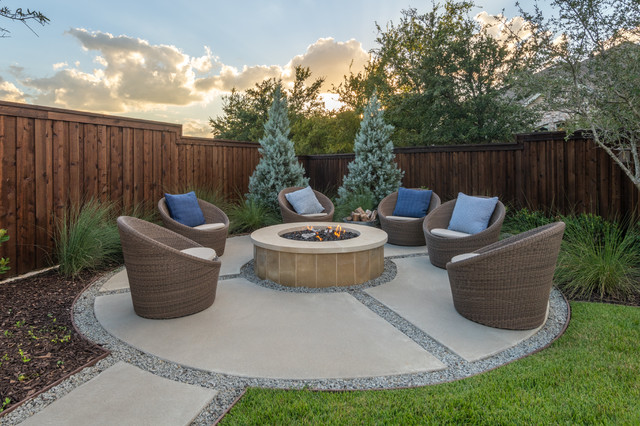

Concrete patios have long been a popular choice for homeowners seeking a versatile, durable, and low-maintenance option for outdoor spaces. Known for their strength and adaptability, concrete patios can be customized to suit a wide range of styles and functional needs. Here’s a detailed look at what concrete patios have to offer and why they might be the ideal solution for your next project.
Benefits of Concrete Patios
Durability: Concrete is renowned for its strength and longevity. A well-installed concrete patio can withstand heavy use and endure harsh weather conditions, including extreme temperatures, rain, and snow. Its resistance to cracking and warping makes it a reliable choice for long-term outdoor use.
Low Maintenance: Once installed, concrete patios require minimal maintenance. They don’t need sealing or staining as frequently as wood or composite materials. Routine cleaning with a broom or hose is usually sufficient to keep the surface looking fresh.
Versatility: Concrete patios can be customized in a variety of ways to match your design preferences. Techniques like stamping, staining, and coloring allow you to mimic the appearance of natural stone, brick, or tile, offering a high degree of aesthetic flexibility.
Cost-Effectiveness: Compared to some other materials like natural stone or high-end composites, concrete can be a more affordable option. Its durability and low maintenance needs also contribute to cost savings over time.
Quick Installation: Concrete patios can be installed relatively quickly compared to other materials. Once the concrete is poured and set, the patio is ready for use, making it a practical choice for homeowners looking for a fast turnaround.
Drawbacks of Concrete Patios
Cracking: While concrete is strong, it can be prone to cracking, especially if not properly installed or if the underlying soil shifts. However, with proper reinforcement and installation techniques, the risk of significant cracking can be minimized.
Temperature Sensitivity: Concrete can become very hot in direct sunlight, which might make it uncomfortable to walk on during peak summer temperatures. Additionally, it can be cold and hard in winter, potentially affecting comfort levels.
Limited Flexibility: Once installed, making significant changes to a concrete patio can be challenging and costly. If you decide to alter the design or layout, it often requires professional intervention.
Appearance Limitations: Although modern techniques have greatly expanded the aesthetic options for concrete patios, some homeowners may still find that it lacks the natural warmth or unique character of materials like wood or stone.
Customization Options
Stamped Concrete: Stamping involves pressing patterns into the wet concrete to mimic the appearance of other materials like brick, slate, or flagstone. This technique adds visual interest and can enhance the overall look of your patio.
Stained Concrete: Staining concrete allows you to add color and depth to the surface. This method can create a variety of effects, from subtle hues to vibrant tones, providing a customizable appearance that suits your design vision.
Exposed Aggregate: This technique involves removing the top layer of cement paste to reveal the underlying aggregate (stones or pebbles). Exposed aggregate provides a textured, decorative finish that’s both visually appealing and slip-resistant.
Polished Concrete: Polishing concrete can create a smooth, glossy finish that’s easy to clean and maintain. It’s often used in modern design schemes for a sleek, contemporary look.
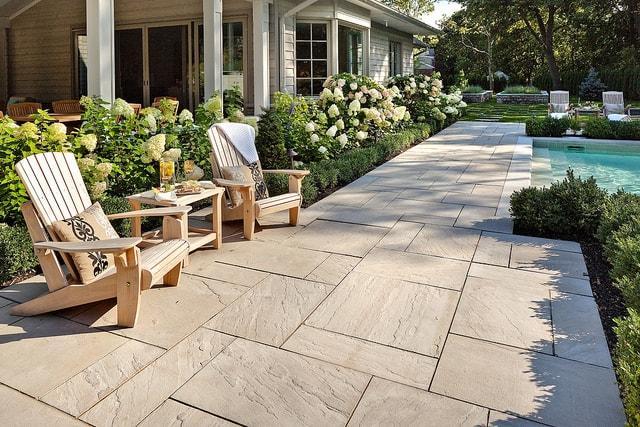

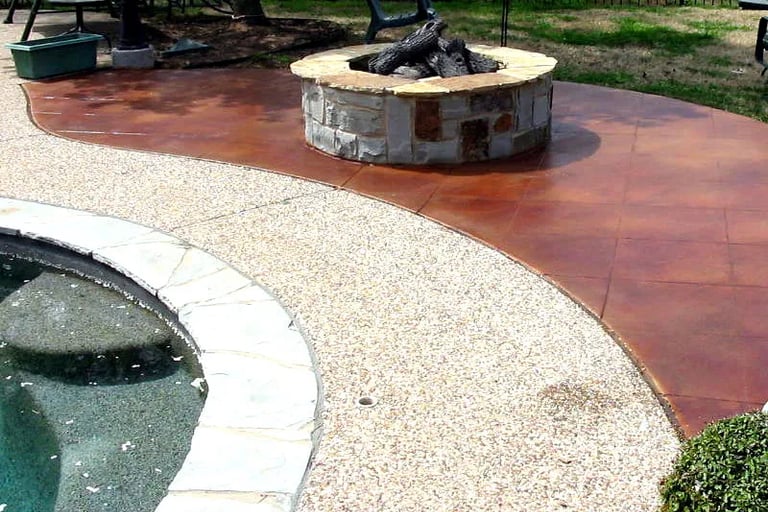

Notes:
PVC Decking: Known for its excellent water and mold resistance, and low maintenance. The high upfront cost is balanced by its long lifespan.
Composite Decking: Offers a good balance between aesthetics, durability, and cost. While it mimics wood less convincingly than PVC, it still provides substantial benefits.
Wood Decking: Provides a classic look but requires significant maintenance and has a shorter lifespan compared to modern alternatives.
Concrete Decking: Durable and low-maintenance, with high water and mold resistance. Its real wood appearance is less convincing but can be customized through staining and stamping.
Vinyl Decking: Offers excellent water and mold resistance with a variety of styles. Its high cost is offset by low maintenance and good durability.
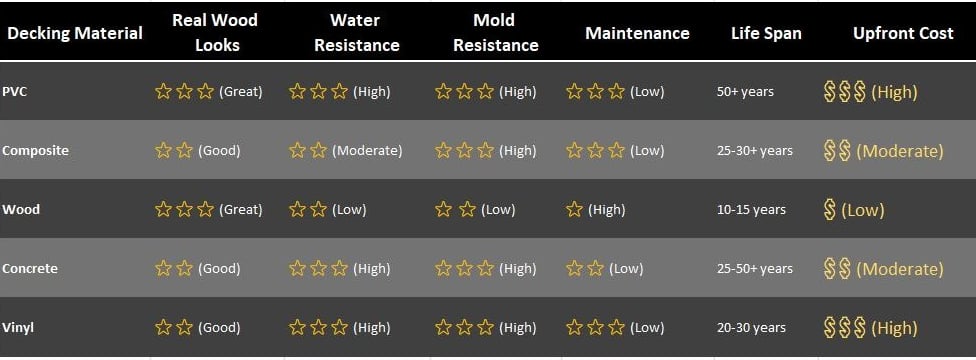

If you're deciding on the best decking material for your home, or if you have any other home improvement needs, choose KHS Group for expert guidance and quality service. Call us or book an in-person consultation today to explore your options and address any concerns. We're here to help with all your home improvement projects!
Serving London, ON & All Nearby Cities
Call us: 226-227-7366
Write to us: Office@khsgroup.ca
For more contacts visit Contacts page


